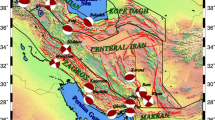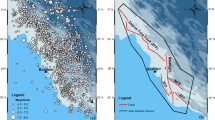Abstract
The main goal of this article is to decluster Iranian plateau seismic catalog by the epidemic-type aftershock sequence (ETAS) model and compare the results with some older methods. For this purpose, Iranian plateau bounded in 24°–42°N and 43°–66°E is subdivided into three major tectonic zones: (1) North of Iran (2) Zagros (3) East of Iran. The extracted earthquake catalog had a total of 6034 earthquakes (Mw > 4) in the time span 1983–2017. The ETAS model is an accepted stochastic approach for seismic evaluation and declustering earthquake catalogs. However, this model has not yet been used to decluster the seismic catalog of Iran. Until now, traditional methods like the Gardner and Knopoff space–time window method and the Reasenberg link-based method have been used in most studies for declustering Iran earthquake catalog. Finally, the results of declustering by the ETAS model are compared with result of Gardner and Knopoff (Bull Seismol Soc Am 64(5):1363–1367, 1974), Uhrhammer (Earthq Notes 57(1):21, 1986), Gruenthal (pers. comm.) and Reasenberg (Geophys Res 90:5479–5495, 1985) declustering methods. The overall conclusion is difficult, but the results confirm the high ability of the ETAS model for declustering Iranian earthquake catalog. Use of the ETAS model is still in its early steps in Iranian seismological researches, and more parametric studies are needed.









Similar content being viewed by others
Abbreviations
- Re:
-
Reasenberg
- Uh:
-
Uhrhammer
- G-K:
-
Gardner and Knopoff
- Gr:
-
Gruenthal method
- ETAS:
-
Epidemic-type aftershock sequence model
References
Amini H (2014) Comparing Reasenberg and Gruenthal declustering methods for north of Iran. In Second European conference on earthquake engineering and seismology
Bottiglieri M, Lippiello E, Godano C, de Arcangelis L (2009) Identification and spatiotemporal organization of aftershocks. J Geophys Res. https://doi.org/10.1029/2008JB005941
Burkhard M, Grünthal G (2009) Seismic source zone characterization for the seismic hazard assessment project PEGASOS by the Expert Group 2 (EG1b). Swiss J Geosci 102(1):149–188
Davis SD, Frohlich C (1991) Single-link cluster analysis, synthetic earthquake catalogs, and aftershock identification. Geophys J Int 104:289–306
Frohlich C, Davis SD (1990) Single-link cluster analysis as a method to evaluate spatial and temporal properties of earthquake catalogs. Geophys J Int 100:19–32
Gardner JK, Knopoff L (1974) Is the sequence of earthquakes in Southern California, with aftershocks removed, Poissonian? Bull Seismol Soc Am 64(5):1363–1367
Gutenberg B, Richter CF (1944) Measurement error models. Bull Seismol Soc Am 34:185–188
Hainzl S, Scherbaum F, Beauval C (2006) Estimating background activity based on interevent-time distribution. Bull Seismol Soc Am 96(1):313–320
Huang WQ, LiWX Cao XF (1994) Research on the completeness of earthquake data in the Chinese mainland (I)North China. Acta Seismol Sin 7(3):351–359
Jalilian A, Zhuang J (2016) ETAS: modeling earthquake data using ETAS model. R package version 0.2. https://CRAN.R-project.org/package=ETAS
Kagan Y, Jackson D (1991) Long-term earthquake clustering. Geophys J Int 104(1):117–134
Kanamori H (1977) The energy release in great earthquakes. J Geophys Res 82(20):2981–2987
Karimiparidari S, Zare M, Memarian H, Kijko A (2013) Iranian earthquakes, a uniform catalog with moment magnitudes. J Seismol 17(3):897–911
Luen B, Stark PB (2012) Poisson tests of declusteredcatalogs. Geophys J Int 189(1):691–700
Marsan D, Lengline O (2010) A new estimation of the decay of aftershock density with distance to the mainshock. J Geophys Res [Solid Earth]. https://doi.org/10.1029/2009JB007119
Mirzaei N, Gao MT, Chen YT, Wang J (1997) A uniform catalog of earthquakes for seismic hazard assessment in Iran. Acta Seismol Sin 10(6):713–726. https://doi.org/10.1007/s11589-997-0003-5
Molchan G, Dmitrieva O (1992) Aftershock identification: methods and new approaches. Geophys J Int 109:501–516
Mousavi-Bafrouei SH, Mirzaei N, Shabani E (2015) A declustered earthquake catalog for the Iranian Plateau. Ann Geophy. https://doi.org/10.4401/ag-6395
Ogata Y (1998) Space-time point-process models for earthquake occurrences. Ann Inst Stat Math 50(2):379–402
Ommi S, Zafarani H, Zare M (2016) Aftershock decay rates in the Iranian plateau. Pure Appl Geophys 173(7):2305–2324 (Springer Basel Switzerland)
Reasenberg P (1985) Second-order moment of central California seismicity. 1969–1982. J Geophys Res 90:5479–5495
Savage WU (1972) Microearthquake clustering near fairview peak, Nevada, and in the Nevada seismic zone. J Geophys Res 77(35):7049–7056
Shahvar MP, Zare M, Castellaro S (2013) A unified seismic catalog for the Iranian plateau (1900–2011). Seismol Res Lett 84(2):233–249
Uhrhammer R (1986) Characteristics of northern and central California seismicity. Earthq Notes 57(1):21
Van Stiphout T, Zhuang J, Marsan D (2012) Seismicity declustering, Community online resource for statistical seismicity analysis. https://doi.org/10.5078/corssa-52382934. Available at http://www.corssa.org
Vere-Jones D (1970) Stochastic models for earthquake occurrence. J Roy Stat Soc: Ser B (Methodol) 32(1):1–62
Wells DL, Coppersmith KJ (1994) New empirical relationships among magnitude, rupture length, rupture width, rupture area, and surface displacement. Bull Seismol Soc Am 84(4):974–1002
Wiemer S (2001) A software package to analyze seismicity: ZMAP. Seismol Res Lett 72:373–382
Zafarani H, Soghrat M (2012) Simulation of ground motion in the Zagros region of Iran using the specific barrier model and the stochastic method. Bull Seismol Soc Am 102(5):2031–2045
Zare M, Amini H, Yazdi P, Sesetyan K, Demircioglu MB, Kalafat D, Erdik M, Giardini D, Asif Khan M, Tsereteli N (2014) Recent developments of the Middle East catalog. J Seismol 18(4):749–772 (Springer)
Zhuang J (2011) Next-day earthquake forecasts for the Japan region generated by the ETAS model. Earth Planets Space 63(3):5 (Springer Japan)
Zhuang J, Ogata Y, Vere-Jones D (2002) Stochastic declustering of space-time earthquake occurrences. J Am Stat Assoc 97(458):369–380
Zhuang J, Ogata Y, Vere-Jones D (2004) Analyzing earthquake clustering features by using stochastic reconstruction. J Geophys Res [Solid Earth]. https://doi.org/10.1029/2003JB002879
Zhuang J, Ogata Y, Vere-Jones D (2006) Diagnostic analysis of space-time branching processes for earthquakes. In: Baddeley A, Gregori P, Mateu J, Stoica R, Stoyan D (eds) Case Studies in Spatial Point Process Modeling. Lecture Notes in Statistics, vol 185. Springer. New York, NY, pp 275–292
Acknowledgements
The authors acknowledge the funding support of Babol Noshirvani University of Technology through Grant No. BUT/388011/97. We wish to appreciate Mohammad Shahvar for his help in providing the earthquake catalog and magnitude conversation relations used in this article.
Author information
Authors and Affiliations
Contributions
HRT proposed the initial idea and guided us in the analysis. ND analyzed the data completed all experiments and wrote the manuscript. MZ directed us to create a seismic catalog and seismic zoning. AJ developed the ETAS model code. All authors read and approved the final manuscript.
Corresponding author
Ethics declarations
Conflict of interest
The authors declare that they have no conflict of interest.
Rights and permissions
About this article
Cite this article
Davoudi, N., Tavakoli, H.R., Zare, M. et al. Declustering of Iran earthquake catalog (1983–2017) using the epidemic-type aftershock sequence (ETAS) model. Acta Geophys. 66, 1359–1373 (2018). https://doi.org/10.1007/s11600-018-0211-5
Received:
Accepted:
Published:
Issue Date:
DOI: https://doi.org/10.1007/s11600-018-0211-5




